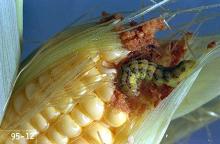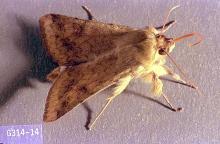Helicoverpa zea
Pest description, crop damage and life history
See:
Common Pests of Vegetable Crops
Pest Monitoring Moths can be sampled with pheromones placed in inverted cone-type traps. A first application of insecticide is made at first silk regardless of moth counts. The presence of five to ten moths per night per trap may be considered a tentative action threshold for additional sprays.
Fresh-market corn has very little tolerance of earworms. Earworm becomes a problem in processing sweet corn when the larvae penetrate deeply into the ear. A single application at first silk during intense moth egg laying events may be justified for processing sweet corn.
Once larvae enter the corn ears, control with insecticides is very difficult. It depends on proper timing and thorough coverage. Begin sampling at first visible silk. The presence of large numbers of eggs on fresh corn silks indicates the potential for damaging populations. Begin treatments during silking stage, at the start of egg hatch. Direct insecticidal control towards young larvae that are feeding on the exposed ear tips.
Management-biological control
Many predators and parasitoids attack corn earworm eggs, including several species of Trichogramma. Most parasitized eggs turn black, but there may be a lag period before they do so. Commercial releases of Trichogramma wasps have been used with mixed results. Generalist predators such as lacewings, minute pirate bugs, and damsel bugs feed on corn earworm eggs and small larvae.
Management-cultural control
In sweet corn, very early plantings often escape significant damage compared with late-season corn, because earworm population densities increase as the season progresses. Some varieties of corn seem to suffer more corn earworm damage than others. These include varieties with tight husks like 'Country Gentleman,' 'Golden Security,' 'Silvergent,' and 'Staygold.' A clothespin placed at the point where the silk enters the ear can prevent earworm access. Plow or dig up plants in the fall to prevent overwintering.
Management-chemical control: HOME USE
Apply when silks first appear. Repeat three to four times as label allows. Direct insecticide application to silk.
- azadirachtin (neem oil)-Some formulations are OMRI-listed for organic use.
- Bacillus thuringiensis var. kurstaki (Btk)-Some formulations are OMRI-listed for organic use.
- bifenthrin (as a mix with zeta-cypermethrin).
- carbaryl
- cyfluthrin
- delatamethrin
- esfenvalerate
- gamma-cyhalothrin
- horticultural oil-Some formulations are OMRI-listed for organic use.
- lambda-cyhalothrin
- permethrin
- pyrethrins-Some formulations are OMRI-listed for organic use.
- spinosad-Some formulations are OMRI-listed for organic use.
- zeta-cypermethrin
Management-chemical control: COMMERCIAL USE
- azadirachtin-See label for application rates. Some formulations are OMRI-listed for organic use.
- alpha-cypermethrin (Fastac EC) at 0.018 to 0.025 lb ai/A. PHI 3 days. REI 12 hr. Retreatment interval 3 days. Do not exceed 0.075 lb ai/A per season.
- beta-cyfluthrin (Baythroid XL) at 0.013 to 0.022 lb ai/A. PHI 0 days. REI 12 hr. Retreatment interval 2 days. Do not exceed a total of 0.22 lb ai/A per growing season.
- bifenthrin/zeta-cypermethrin (Hero) at 0.04 to 0.1 lb ai/A. PHI 3 days. REI 12 hr. Retreatment interval 3 to 5 days. Do not exceed 0.266 lb ai/A per season.
- borate complex (Prev-Am) applied as a 0.8% solution. Apply to complete coverage. REI 24 hr. Retreatment interval 7 days. OMRI-listed for organic use.
- bifenthrin (Capture LFR) at 0.033 to 0.1 lb ai/A. PHI 1 day. REI 12 hr. Do not exceed 0.2 lb ai/A per season.
- Burkholderia spp. (Venerate XC) at 1 to 4 quarts/A product. PHI 0 days. REI 4 hr. OMRI-listed for organic use.
- carbaryl (Sevin XLR Plus) at 1 to 2 lb ai/A. PHI 2 days for harvest of ears, 14 days for forage, 48 days for fodder. REI 24 hr. Retreatment interval 3 days. Limit 8 treatments per year Do not exceed 16 lb ai/A per crop.
- chlorantraniliprole (Coragen) at 0.045 to 0.098 lb ai/A. PHI 1 day. REI 4 hr. Limit 4 treatments per crop. Retreatment interval 1 day. Do not exceed 0.2 lb ai/A per season.
- chlorantraniliprole/lambda-cyhalothrin (Besiege) at 0.06 to 0.1 lb ai/A. PHI 1 day. REI 24 hr. Retreatment interval 1 day. Do not exceed 0.48 lb ai of lambda-cyhalothrin or 0.2 lb ai of chlorantraniliprole per acre per growing season.
- Chromobacterium subtsugae (Grandevo) at 0.3 to 0.9 lb ai/A per 100 gal. PHI 0 days. REI 4 hr. OMRI-listed for organic use.
- cyfluthrin (Tombstone) at 0.025 to 0.044 lb ai/A. PHI 0 days. REI 12 hr. Retreatment interval 2 days. Do not exceed 0.44 lb ai/A per season.
- deltamethrin (Delta Gold) at 0.018 to 0.028 lb ai/A. PHI 1 day. REI 12 hr. Do not apply more than 0.45 lb ai/A in one growing season.
- esfenvalerate (Asana XL) at 0.03 to 0.05 lb ai/A. PHI 1 day. REI 12 hr. Do not exceed 0.5 lb ai/A per year.
- gamma-cyhalothrin (Declare) at 0.0075 to 0.0125 lb/A. PHI 1 day. REI 24 hr. Do not graze. Do not exceed 0.24 lb ai/A per season.
- indoxacarb (Avaunt) at 0.045 to 0.065 lb ai/A for application through tassle push only. PHI 3 days; 35 days for fodder & stover. REI 12 hr. Limit 4 treatments per season. Do not exceed 0.26 lb ai/A per crop.
- lambda-cyhalothrin (Warrior II) at 0.02 to 0.03 lb ai/A. PHI 1 day. REI 24 hr. Do not exceed 0.48 lb ai/A per year. Retreatment interval 4 days. Do not harvest for feed or graze livestock for 21 days.
- lambda-cyhalothrin/tebuconazole (Crossover) at 0.14 to 0.16 lb ai/A. REI 19 days. PHI 21 days for ears & forage; 49 days for fodder. Do not exceed 0.48 lb ai/A tebuconazole or 0.12 lb ai/A lambda-cyhalothrin. Product not registered for use in WA.
- malathion (Malathion 5EC) at 1.0 lb ai/A. PHI 5 days. REI is 72 hr for detasseling and 12 hr for all other activities. Retreatment interval 5 days. Limit 2 treatments per year.
- methomyl (Lannate SP) at 0.3 to 0.45 lb ai/A. PHI 0 days for ears, 3 days for forage, and 21 days for stover. REI 48 hr. Do not exceed 6.3 lb ai/A per season.
- mineral oil-Apply direct to silk. OMRI-listed for organic use.
- novaluron (Rimon 0.83EC) at 0.039 to 0.078 lb ai/A. PHI 1 day. REI 12 hr. Retreatment interval 7 days. Do not exceed 0.39 lb ai/A per season.
- permethrin (Pounce 25WP) at 0.1 to 0.2 lb ai/A. PHI 1 day. REI 12 hr. Retreatment interval 5 days. Do not exceed and 0.8 lb ai/A for Pounce per season.
- polyhedral occlusion bodies (Gemstar LC) at 4 to 10 fl oz formulated product per acre. PHI 0 days. REI 4 hr. Retreatment interval 2 days. OMRI-listed for organic production.
- spinetoram (Radiant SC) at 0.023 to 0.0469 lb ai/A. PHI 1 day for ears, 3 days for forage. REI 4 hr. Retreatment interval 2 days at silking. Do not exceed six applications or 0.281 lb ai/A per season. Follow resistance management procedures on the label.
- spinosad (Success, Entrust SC) at 0.047 to 0.094 lb ai/A. PHI 1 day for ears, 7 days for forage. REI 4 hr. Treat eggs at hatch and small larvae. Do not exceed 0.45 lb ai/A per crop. Spinosad takes several days to achieve full effect. Monitor fields and pest populations carefully. Multiple applications may be necessary. Entrust SC is OMRI-listed for organic use.
- zeta-cypermethrin (Mustang) at 0.028 to 0.05 lb ai/A. PHI 3 days for grain, stover & forage. REI 12 hr. Do not exceed 0.3 lb ai/A per season. Retreatment interval 3 to 5 days.



